Gary Nichols. Sedimentology and Stratigraphy(Second Edition)
Подождите немного. Документ загружается.

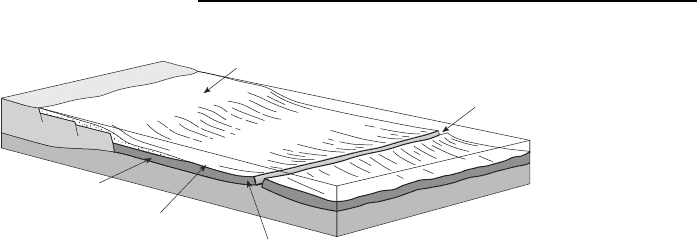
from river and delta systems and bypasses the shelf.
There is also intrabasinal material available in ocean
basins, comprising mainly the hard part of plants
and animals that live in the open oceans, and air-
borne dust that is blown into the oceans. These
sources of sediment all contribute to oceanic deposits
(Douglas 2003). The large clastic depositional sys-
tems are mainly found near the margins of the ocean
basin, although large systems may extend a thou-
sand kilometres or more out onto the basin plain,
and the ocean basin plains provide the large st
depositional environments on Earth.
The problem with these deep-water depositional
systems, however, is the difficulty of observing and
measuring processes and products in the present day.
The deep seas are profoundly inaccessible places. Our
knowledge is largely limited to evidence from remote
sensing: detailed bathymetric surveys, side-scan sonar
images of the sea floor and seismic reflection surveys
(22.2) of the sediments. There are also extremely
localised samples from boreholes, shallow cores and
dredge samples. Our database of the modern ocean
floors is comparable to that of the surface of the Moon
and understanding the sea floor is rather like trying to
interpret all processes on land from satellite images
and a limited number of hand specimens of rocks
collected over a large area. However, our knowledge
of deep-water systems is rapidly growing, partly
through technical advances, but also because hydro-
carbon exploration has been gradually moving into
deeper water and looking for reserves in deep-water
deposits.
16.1.1 Morphology of ocean basins
Continental slopes typically have slope angles of
between 28 and 108 and the continental rise is even
less (11.1). Nevertheless, they are physiographically
significant, as they contrast with the very low gradi-
ents of continental shelves and the flat ocean floor.
Continental slopes extend from the shelf edge, about
200 m below sea level, to the basin floor at 4000 or
5000 m depth and may be up to a hundred kilometres
across in a downslope direction. Continental slopes
are commonly cut by submarine canyons, which,
like their counterparts on land, are steep-sided ero-
sional features. Submarine canyons are deeply
incised, sometimes into the bedrock of the shelf, and
may stretch all the way back from the shelf edge to
the shoreline. They act as conduits for the transfer of
water and sediment from the shelf, sometimes feeding
material directly from a river mouth. The presence of
canyons controls the formation and position of sub-
marine fans.
The generally flat surface of the ocean floor is
interrupted in places by seamounts, underwater
volcanoes located over isolated hotspots. Seamounts
may be wholly submarine or may build up above
water as volcanic islands, such as the Hawaiian
island chain in the central Pacific. As subaerial volca-
noes they can be important sources of volcaniclastic
sediment to ocean basins. The flanks of the volcanoes
are commonly unstable and give rise to very large-
scale submarine slides and slumps that can involve
several cubic kilometres of material. Bathymetric
mapping and sonar images of the ocean floor around
volcanic islands such as Hawaii in the Pacific and the
Canary Islands in the Atlantic have revealed the
existence of very large-scale slump features. Mass
movements on this scale would generate tsunami
(11.3.2) around the edges of the ocean, inundating
coastal areas.
The deepest parts of the oceans are the trenches
formed in regions where subduction of an oceanic
plate is occurring. Trenches can be up to 10,000 m
shelf
mid-ocean ridge
surface of ocean crust
deepens away from
mid-ocean ridge
young, buoyant crust
old, denser crust
Fig. 16.1 Deep water environments are floored by ocean crust and are the most widespread areas of deposition worldwide.
248 Deep Marine Environments

deep. Where they occur adjacent to continental
margins (e.g. the Peru–Chile Trench west of South
America) they are filled with sediment supplied from
the continent, but mid-ocean trenches, such as the
Mariana Trench in the west Pacific, are far from
any source of material and are unfilled, starved of
sediment.
16.1.2 Depositional processes in deep seas
Deposition of most clastic material in the deep seas is
by mass-flow processes (4.5). The most common are
debris flows and turbidity currents, and these form
part of a spectrum within which there can be flows
with intermediate characteristics.
Debris-flow deposits
Remobilisation of a mass of poorly sorted, sediment-
rich mixture from the edge of the shelf or the top of
the slope results in a debris flow, which travels down
the slope and out onto the basin plain. Unlike a debris
flow on land an underwater flow has the opportunity
to mix with water and in doing so it becomes more
dilute and this can lead to a change in the flow
mechanism and a transition to a turbidity current.
The top surface of a submarine debris flow deposit will
typically grade up into finer deposits due to dilution of
the upper part of the flow. Large debris flows of mate-
rial are known from the Atlantic off northwest Africa
(Masson et al. 1992) and examples of thick, extensive
debris-flow deposits are also known from the strati-
graphic record (Johns et al. 1981; Pauley 1995).
Debris-flow deposits tens of metres thick and extend-
ing for tens of kilometres are often referred to as
megabeds.
Turbidites
Dilute mixtures of sediment and water moving as
mass flows under gravity are the most important
mechanism for moving coarse clastic material in
deep marine environments. These turbidity currents
(4.5.2) carry variable amounts of mud, sand and
gravel tens, hundreds and even over a thousand kilo-
metres out onto the basin plain. The turbidites depos-
ited can range in thickness from a few millimetres to
tens of metres and are carried by flows with sediment
concentrations of a few parts per thousand to 10%.
Denser mixtures result in high-density turbidites
that have different characteristics to the ‘Bouma
Sequences’ seen in low- and medium-density turbi-
dites. Direct observation of turbidity currents on the
ocean floor is very difficult but their effects have been
monitored on a small number of occasions. In Novem-
ber 1929 an earthquake in the Grand Banks area off
the coast of Newfoundland initiated a turbidity cur-
rent. The passage of the current was recorded by the
severing of telegraph cables on the sea floor, which
were cut at different times as the flow advanced.
Interpretation of the data indicates that the turbidity
current travelled at speeds of between 60 and
100 km h
1
(Fine et al. 2005). Also, the deposits of
recent turbidity flows have been mapped out, for
example, in the east Atlantic off the Canary Islands
a single turbidite deposit has been shown to have a
volume of 125 km
3
(Masson 1994).
High- and low-efficiency systems
A deep marine depositional system is considered
to be a low-efficiency system if sandy sediment is
carried only short distances (tens of kilometres) out
onto the basin plain and a high-efficiency system if
the transport distances for sandy material are hun-
dreds of kilometres (Mutti 1992). High-volume flows
are more efficient than small-volume flows and the
efficiency is also increased by the presence of fines
that tend to increase the density of the flow and
hence the density contrast with the seawater. The
deposits of low-efficiency systems are therefore con-
centrated near the edge of the basin, whereas mud-
dier, more efficient flows carry sediment out on to the
basin plain. The high-efficiency systems will tend to
have an area near the basin margin called a
bypass zone where sediment is not deposited, and
there may be scouring of the underlying surface,
with all the deposition concentrated further out in
the basin.
Initiation of mass flows
Turbidity currents and mass flows require some form
of trigger to start the mixture of sediment and water
moving under gravity. This may be provided by an
earthquake as the shaking generated by a seismic
shock can temporarily liquefy sediment and cause it
to move. The impact of large storm waves on shelf
sediments may also act as a trigger. Accumulation of
Ocean Basins 249

sediment on the edge of the shelf may reach the point
where it becomes unstable, for example where a delta
front approaches the edge of a continental shelf. High
river discharge that results in increased sediment
supply can result in prolonged turbidity current flow
as sediment-laden water from the river mouth flows
as a hyperpycnal flow across the shelf and down onto
the basin plain. Such quasi-steady flows may last
for much longer periods than the instantaneous trig-
gers that result in flows lasting just a few hours. A fall
in sea level exposes shelf sediments to erosion, more
storm effects and sediment instability that result in
increased frequency of turbidity currents.
16.1.3 Composition of deep marine deposits
The detrital material in deep-water deposits is highly
variable and directly reflects the sediment source area.
Sand, mud and gravel from a terrigenous source are
most common, occurring offshore continental mar-
gins that have a high supply from fluvial sources.
Material that has had a short residence time on the
shelf will be similar to the composition of the river but
extensive reworking by wave and tide processes can
modify both the texture and the composition of the
sediment before it is redeposited as a turbidite. A
sandstone deposited by a turbidity current can there-
fore be anything from a very immature, lithic wacke
to a very mature quartz arenite. Turbidites composed
wholly or partly of volcaniclastic material occur in
seas offshore of volcanic provinces. The deep seas near
to carbonate shelves may receive large amounts of
reworked shallow-marine carbonate sediment, rede-
posited by turbidity currents and debris flows into
deeper water: recognition of the redeposition process
is particularly important in these cases because the
sediment will contain bioclastic material that is char-
acteristic of shallow water environments. Because
there is this broad spectrum of sandstone composi-
tions in deep-water sediments, the use of the term
‘greywacke’ to describe the character of a deposit is
best avoided: it has been used historically as a descrip-
tion of lithic wackes (2.3.3 ) that were deposited as
turbidites and the distinction between composition
and process became confused as the terms turbidite
and greywacke came to be used almost as synonyms.
‘Greywacke’ is not part of the Pettijohn classification
of sandstones and it no longer has any widely
accepted meaning in sedimentology.
16.2 SUBMARINE FANS
A submarine fan is a body of sediment on the sea
floor deposited by mass-flow processes that may be
fan-shaped, but more elongate, lobate geometries are
also common (Fig. 16.2). They vary in size from a few
kilometres radius to depositional systems covering
over a million square kilometres and forming some
of the largest geomorphological features on Earth.
The morphology and depositional character of sub-
marine fan systems are strongly controlled by the
composition of the material supplied, particularly the
proportions of gravel, sand and mud present. In this
sense submarine fans are very much like other deposi-
tional systems such as deltas (Chapter 12), which also
show considerable variability depending on the grain-
size distribution in the material supplied. Note that
although coarse-grained deltas are sometimes referred
to as fan deltas and are largely submarine, the term
submarine fan is restricted to fan-shaped bodies that
sediment supply
shelf canyon
shelf
medial fan lobe deposits
10s-1000s kilometres
basin
plain
proximal fan channel and levee deposits
distal fan
deposits
Fig. 16.2 Depositional environments on
a submarine fan.
250 Deep Marine Environments
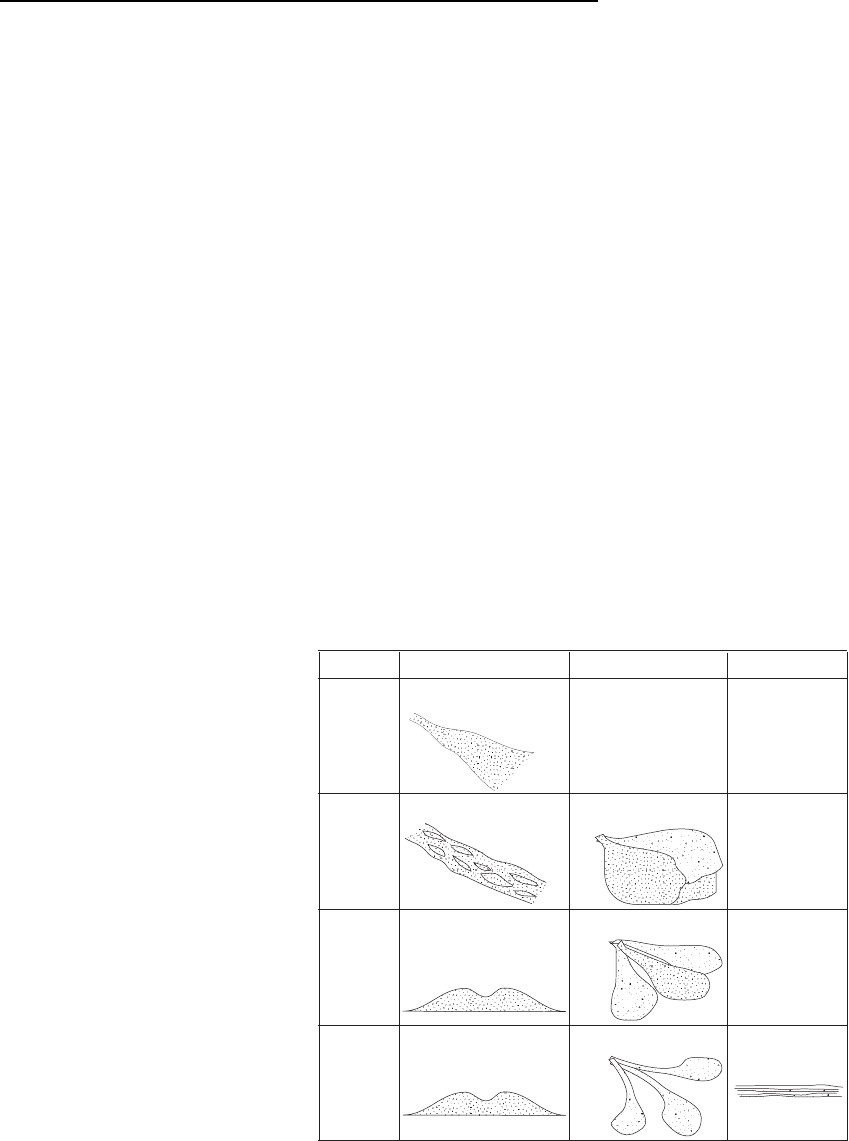
are deposited by mass-flow, mainly turbidity current,
processes.
A submarine fan could form of any clastic mate-
rial, but the larger fans are all composed of terri-
genous c lastic material supplied by large river
systems. Carbonate shelves can be impor tant
sources of sediment redeposited in the ocean basins
by turbidites, but the supply of carbonate sediment
is rarely focused at discrete points along the con-
tinental slope: submarine fans composed of carbo-
nate ma terial are therefore rarely formed, and most
carbonate turbidites are a ssociated with slope-apron
systems (16.3).
16.2.1 Architectural elements of submarine
fan systems
A submarine fan can be divided into a number of
‘architectural elements’, components of the deposi-
tional system that are the products of different pro-
cesses and subenvironments of deposition (Fig. 16.3).
Submarine fan channels form distinct elements on
the fan surface and may have levees associated with
them: these channels may incise into, or pass distally
into, depositional lobes, which are broad, slightly
convex bodies of sediment.
Submarine fan channels and levees
The canyons that incise into the shelf edge funnel
sediment and water to discrete points at the edge of
the ocean basin where turbidity currents flowing
down the canyons pass into channels. Unlike the
canyons, the channels are not incised into bedrock,
but may scour into underlying submarine fan deposits
(Fig. 16.4). Submarine fan channels are variable in
size: some of the larger modern examples are several
tens of kilometres wide and over a thousand metres
deep, and in the stratigraphic record there are sub-
marine fan channels with thicknesses of up to 170 m
and 20 km across (Macdonald & Butterworth 1990).
The deposits in the channel are typically coarse sands
and gravel that form thick, structureless or crudely
graded beds characterised by T
ab
of the Bouma
sequence and S
1–3
of the ‘Lowe-type’ high-density
turbidite model (4.5.2). The lateral extent of these
turbidite beds is limited by the width of the channel,
which, when it is filled, forms a lenticular body made
up of stacked coarse-grained turbidites.
Fig. 16.3 The proportions of different
architectural elements on submarine fans
are determined by the dominant grain size
deposited on the fan.
poorly channelised
braided channels
channel and levee
complexes
channel and levee
complexes
channelised lobes
depositional lobes
depositional lobes
sheets
Muddy
systems
Mixed sand
and mud
systems
Sand-rich
systems
Gravel-rich
systems
Channels Lobes
Sheets
Submarine Fans 251
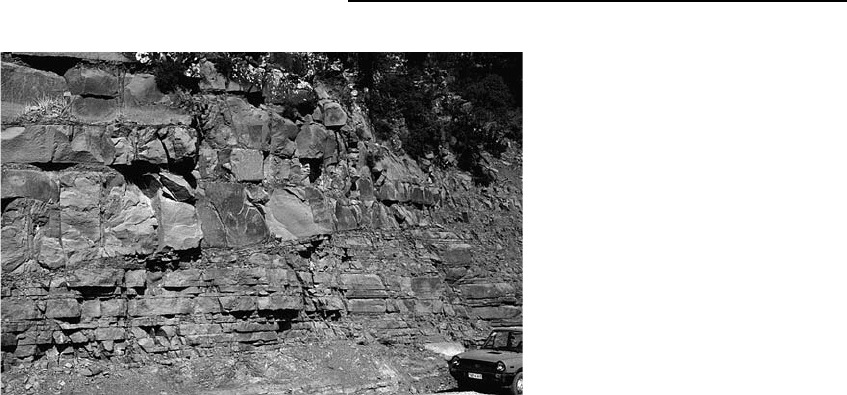
Most of an individual turbidity flow is confined to
the channel but the upper, more dilute part of the
flow may spill out of the channel l aterally. This is
analogous to the channel and ov erbank setting
familiar from fluvial environments (Chapter 9).
The overbank flow from the channel contains fine
sand, silt and mud and this spreads out as a fine-
grained turbidity current away from the channel to
form a submarine channel levee. The levee turbi-
dites consist of the upper parts of Bouma sequences
(T
c–e
and T
de
) and they thin away from the channel
margin with a low-angle, wedge-shaped geometry.
Levee successions can build up to form units
hundreds of metres thick, especially if the channel is
aggrading, that is, filling up with sediment and
building up its banks at the same time. Channel and
levee complexes are also preserved when the channel
migrates laterally or avulses, to leave its former
position abandoned.
Depositional lobes
At the distal ends of channels the turbidity currents
spread out to form a lobe of turbidite deposits that
occupies a portion of the fan surface. An individual
lobe is constructed by a succession of turbidity cur-
rents that tend to deposit further and further out on
the lobe through time. A simple progradational geom-
etry results if fan deposition is very ordered, with each
turbidity current event of approximately the same
magnitude and each depositing progressively further
from the mouth of the channel. However, turbidity
currents are of varying magnitude and so the pattern
tends to be more complex. As the lobe builds out the
flow in the more proximal part tends to become chan-
nelised. Lobe progradation continues until the chan-
nel avulses to another part of the fan. Avulsion occurs
because an individual lobe will start to build up above
the surrounding fan surface and eventually flows
start to follow the slightly steeper gradient on to a
lower area of the fan.
The succession built up by depositional lobe pro-
gradation is ideally a coarsening-up succession
capped by a channelised unit (Fig. 16.5). Individual
turbidites will show normal grading but as the lobe
progrades currents will carry coarser sediment
further out on the fan surface. Successive deposits
therefore should contain coarser sediment and
hence generate an overall coarsening-up pattern. A
thickening-up of the beds should accompany the
coarsening-up pattern (Fig. 16.5). Commonly this
overall coarsening-up and thickening-up is not seen
because of the complex, often random pattern of
deposition on depositional lobes (Anderton 1995).
Therefore there may not be any consistent vertical
pattern of beds deposited on a submarine fan lobe.
Depositional lobe deposits often contain the most
complete Bouma sequences (T
a–e
and T
b–e
). The
whole lobe succession may be tens to hundreds of
metres thick and an individual lobe may be kilometres
or tens of kilometres across. Lobes will be stacked both
vertically and laterally against each other, although
the lateral limits of an individual lobe may be difficult
to identify.
Fig. 16.4 Thick sandstone beds
deposited in a channel in the proximal
part of a submarine fan complex.
252 Deep Marine Environments
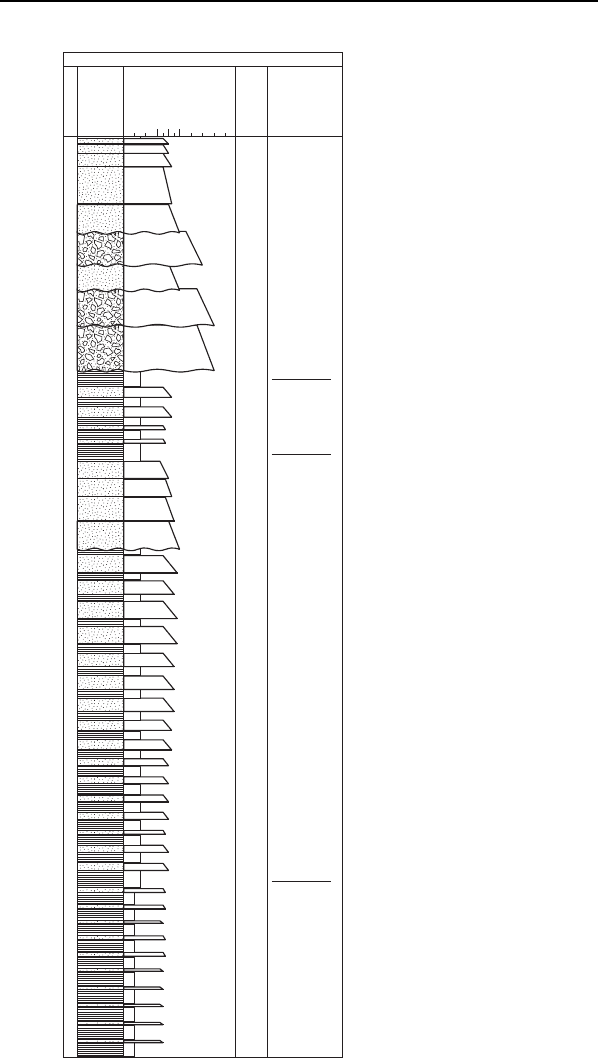
Turbidite sheets
Turbidite sheets are deposits of turbidity currents
that are not restricted to deposition on a lobe but
have spread out over a larger area of the fan. They
are thin, fine-grained turbidites characterised by
Bouma divisions T
c–e
and T
de
with little or no organi-
sation into patterns or trends in grain size and bed
thickness (Fig. 16.6). Interbedding with hemipelagic
mudstones (16.5.3) is common.
16.2.2 Submarine fan systems
The architectural elements described are found in
various proportions and are made up of different
grain sizes of material depending on the characteris-
tics and volume of the sediment supplied to the sub-
marine fan. Any combination is possible, but it is
convenient to consider four representative models:
gravel-dominated, sandy, mixed sand and mud, and
muddy, with the usual caveat that any intermediate
form can exist. The examples shown in Figs 16.7–
16.10 are for systems that have a single entry point
supplying a fan-shaped body of sediment, but for each
case there are also scenarios of multiple supply points,
which form coalescing bodies of sediment that do not
form an overall fan-shape (Reading & Richards 1994;
Stow et al. 1996). Submarine fan systems are com-
monly divided into upper fan (inner fan), mid-fan and
lower fan (outer fan) areas: in these schemes the
upper fan is dominated by channel and levee com-
plexes, the mid-fan by depositional lobes and the
lower fan by sheets. Although this works well for
some examples (e.g. sandy and mixed systems) the
divisions are not so appropriate for gravelly and
muddy systems (see below).
Gravel-rich systems
Coarse sediment may be deposited at the edge of a
basin in coarse-grained deltas supplied by braided
river or alluvial fans. The deeper parts of these deltas
can merge into small submarine fans of material
forming wedge-shaped bodies at the base of the slope
(Fig. 16.7). The gravel is mainly deposited by debris
flows and sands are rapidly deposited by high-density
turbidity currents. These fan bodies tend to pass
abruptly into thin-bedded distal turbidites and hemi-
pelagic mudstones.
Distal fan. Thin,
fine-grained
turbidites
Mid-fan.
Coarsening-up
succession of sandy
turbdites
100s
metres
Mid-fan. Channel
on lobe
Inner Fan.
Thin-bedded levee
deposits
Inner fan.
Submarine fan
channel filled with
thick conglomerate
and sandstone
turbidites
MUD
clay
silt
vf
SAND
f
m
c
vc
GRAVEL
gran
pebb
cobb
boul
Submarine fan
Scale
Lithology
Structures etc
Notes
Fig. 16.5 Schematic graphic sedimentary logs through
submarine fan deposits: proximal, mid-fan lobe deposits and
lower fan deposits.
Submarine Fans 253
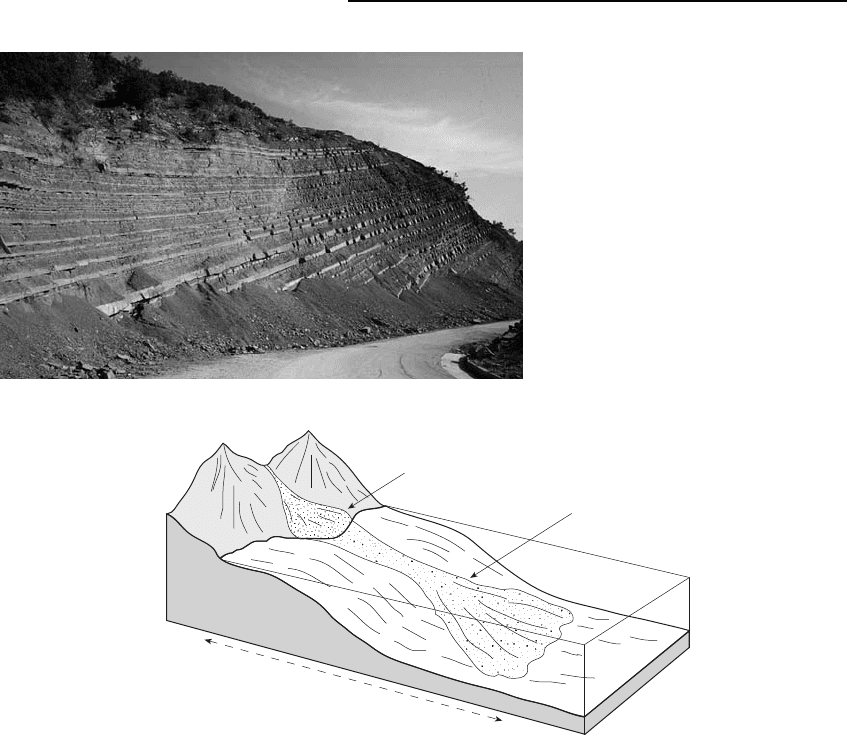
Sand-rich systems
A submarine fan system is considered to be sand-rich
if at least 70% of the deposits in the whole system are
sandy material (Fig. 16.8). They are usually sourced
from sand-rich shelves where waves, storms and tidal
currents have sorted the material, removing most of
the mud and leaving a sand-rich deposit that is
reworked by turbidity currents. Sand-rich turbidity
currents have a low efficiency and do not travel very
far, so the fan body is likely to be relatively small, less
than 50 km in radius (Reading & Richards 1994).
Deposition is largely by high-density turbidity cur-
rents and the fan is characterised by sandy channels
and lobes. The inner fan area is dominated by chan-
nels with some lobes, while the mid-fan area is mainly
coalesced lobes, often channelised. Due to the low
transport efficiency the transition to finer grained
sheet deposits of the lower fan is abrupt. Inactive
areas of the fan (abandoned lobes) become blanketed
by mud. Strata formed by these systems consist of
thick, moderately extensive packages of sandy high-
density turbidites separated by mud layers that repre-
sent the periods of lobe abandonment.
Mixed sand–mud systems
Where a river/delta system provides large quantities of
both sandy and muddy material, a mixed sand–mud
Fig. 16.6 A succession of sandy and
muddy turbidite beds deposited on the
distal part of a submarine fan complex.
steep hinterland relief
coarse alluvial supply
narrow shelf
coarse mass flow deposits
kilometres
deep sea
floor
Fig. 16.7 Facies model for a gravel-rich submarine fan: typically found in front of coarse fan deltas, the fan is small and
consists mainly of debris flows.
254 Deep Marine Environments

depositional system results; these systems are defined
as consisting of between 30% and 70% sand
(Fig. 16.9). These higher efficiency systems are tens
to hundreds of kilometres in diameter and consist of
well-developed channel levee systems and deposi-
tional lobes. Deposits in the channels in the inner
and mid-fan areas include lags of coarse sandstone,
sandy, high-density turbidite beds and channel aban-
donment facies that are muddy turbidites (Reading &
Richards 1994). They form lenticular units flanked by
levee deposits of thin, fine-grained turbidites and
muds. The depositional lobes of the mid-fan are very
variable in composition, including both high- and
lower density turbidites, becoming muddier in the
lower fan area. In a sedimentary succession, the lobe
deposits form very broad lenses encased in thin sheets
of the lower fan and muds of the basin plain.
Muddy systems
The largest submarine fan systems in modern oceans
are mud-rich (Stow et al. 1996), and are fed by very
large rivers. These large mud-rich fans include the
Bengal Fan fed by the Ganges and Brahmaputra rivers
and the large submarine fan beyond the mouth of the
Mississippi. These submarine fan systems are over
1000 km in radius and consist of less than 30%
sand (Fig. 16.10). Channels are the dominant archi-
tectural element of these systems and when some
modern submarine fan channels are viewed in plan
they are seen to follow a strongly sinuous course that
looks like a meandering river pattern (Reading &
Richards 1994). The channels deposits are sandy
while some sand and more mud are deposited on
the channel margins as well-developed levees.
mainly sandy supply
(e.g. from sandy delta)
shelf canyon
shelf
sandy lobe deposits
10s kilometres
deep sea
floor
Fig. 16.8 Facies model for a sand-rich submarine fan: sand-rich turbidites form lobes of sediment that build out on the basin
floor, with switching of the locus of deposition occurring through time.
mixed sandy and
muddy sediment
supply
shelf canyon
shelf
sandy and muddy
lobe deposits
10s-100s kilometres
deep sea
floor
Fig. 16.9 Facies model for a mixed sand–mud submarine fan: the lobes are a mixture of sand and mud and build further out as
the turbidites travel longer distances.
Submarine Fans 255
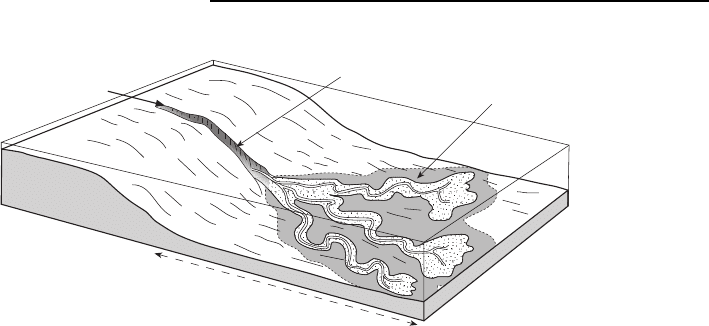
Depositional lobes are rather poorly developed and
thin: the outer fan area consists mainly of thin sand-
stone sheets interbedded with mudrocks of the basin
plain. In a succession of mud-rich fan deposits the
sandstone occurrences are limited to lenticular chan-
nel units and isolated, thin lobes and sheets in the
lower fan.
16.2.3 Ancient submarine fan systems
Successions of turbidites are found in places where
deep-sea deposits have been uplifted by tectonic forces
and are now exposed on land: this occurs at ocean
margins where accretionary prisms form (24.3.2) and
around mountain belts where foreland basin deposits
are thrust to the surface (24.4.1). The beds are com-
monly quite deformed, having been folded and faulted
during the process of uplift, so interpretation of the
successions, which may be many thousands of metres
thick, is not always easy. The type of depositional
system can be assessed by considering the ranges of
the grain sizes of the material and the distribution of
channel, levee, lobe and sheet facies. Because of the
size of most submarine fan systems, the beds exposed
will often represent only a very small part of a whole
system, even if the outcrop extends for tens of kilo-
metres or more.
The palaeogeography of the system can be estab-
lished by using the distribution of the different facies,
and by using indicators of palaeoflow. Scouring during
the flow of a turbidity current leaves marks on the
underlying surface that are filled in as casts when
deposition subsequently occurs. These scour and tool
marks (4.7) can be very abundant on the bases of
turbidite sandstone beds and measurement of their
orientation can be used to determine the direction of
flow of the turbidity current: flute marks indicate the
flow direction while groove marks show the orienta-
tion of the axis of the flow. Cross-lamination in the
Bouma ‘c’ division can also be measured and used as
a palaeocurrent indicator. Palaeoflow indicators in
turbidites provide reliable information about where
the source area was (back-tracking along the flow
directions), except where a turbidity current encoun-
ters an obstacle and is diverted or in small basins
where they may flow all the way across to the oppo-
site margin and rebound back again.
Through time a deep-water basin may be wholly or
partially filled up with the deposits of a submarine fan.
During this process the fan system will prograde as it
builds out into the basin. This means that the deposits
of the lower fan will be overlain by mid-fan deposits
and capped by upper fan facies (Fig. 16.5), but the
succession is unlikely to be as simple as presented in
this diagram.
16.3 SLOPE APRONS
Slope aprons are depositional systems on continental
slopes and adjacent parts of the basin floor that are
not fed by discrete point sources but instead have a
linear supply from a stretch of the shelf. Deposition is
by mass flow processes ranging from submarine slides
and slumps to debris flows and turbidity currents
(Fig. 16.11). Coarser debris tends to move as ava-
lanches of detritus, including blocks of rock metres
muddy sediment supply
shelf canyon
shelf
muddy lobe deposits
100s kilometres
deep sea
floor
Fig. 16.10 Facies model for a muddy submarine fan: lobes are very elongate and most of the sand is deposited close to the
channels.
256 Deep Marine Environments
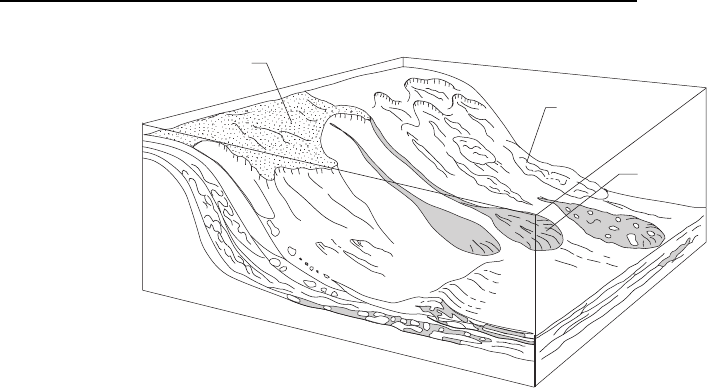
to tens of metres across known as olistoliths, and as
debris flows of material that accumulate on the slope.
Sand reworked from the edge of the shelf is trans-
ported as high-density turbidity currents down the
slope to form spill-over sand deposits (Stow 1986).
Mud and mixtures of sand and mud are redistributed
further down the slope and onto the adjacent plain by
turbidity currents. Finer deposits on the slope are
reworked by debris flows and as more coherent slides
and slumps of material.
The proportions of gravel, sand and mud will be
determined by the nature of the sediment supply from
the shelf edge and there is additionally hemipelagic
deposition on the slope. The mass-flow deposits are
therefore often interbedded with hemipelagic muds,
although these are sometimes remobilised and
deformed in slump units. The character of slope
basin deposits therefore tends to be heterogeneous
and generally chaotic. At the edges of carbonate plat-
forms carbonate slopes may develop at angles ran-
ging from a few degrees to slopes in excess of 308
(Wright & Burchette 1996). The steeper slopes are
sites of slumping and redeposition of material by deb-
ris flows, while at the base of the slope an apron of
carbonate turbidites is deposited.
16.4 CONTOURITES
Ocean currents that are geostrophic and/or thermo-
haline in origin (11.4) are mainly currents that flow
along the sea floor parallel to, or nearly parallel to, the
bathymetric contours of the continental margin. The
deposits of bottom currents are hence called contour-
ites. The contour currents are significant in the dee-
per marine environments and therefore contourites
are not considered to accumulate on shelf areas. Con-
tourites may be sheets of fine muddy and silty sedi-
ment, known as ‘drifts’, that cover hundreds of
thousands to millions of square kilometres on the
abyssal plain and may be tens to hundreds of metres
thick (Stow et al. 1998). Sometimes they form more
elongate bodies parallel to the basin margin, formed
by bottom (contour) currents that may be strong
enough to transport sand. Their composition depends
on the material available to the current and may be
terrigenous, calcareous, or volcaniclastic: the grain
size and sedimentary structures formed depend on
the flow velocity.
In contrast to turbidites, which are single event
deposits, contourites are the products of continuous
flow, and their characteristics are determined by var-
iations in the current velocity, the amount and type of
sediment supply and the degree of modification by
processes such as bioturbation. A cycle of increase
followed by decrease in velocity would produce a
reverse and then normally graded pattern
(Fig. 16.12), but other patterns are possible. Con-
tourites can be difficult to recognise in the strati-
graphic record, and a fine-grained deposit can often
only be confidently interpreted as the product of a
bottom current if it can be shown that it was not
Spill-over sands
Sea level
Slumps
Debris
flows
Pelagic
muds
Fig. 16.11 Slope apron deposits include pelagic sediment, slumps, debris flows and sands from the shelf edge.
(From Stow 1986.)
Contourites 257
